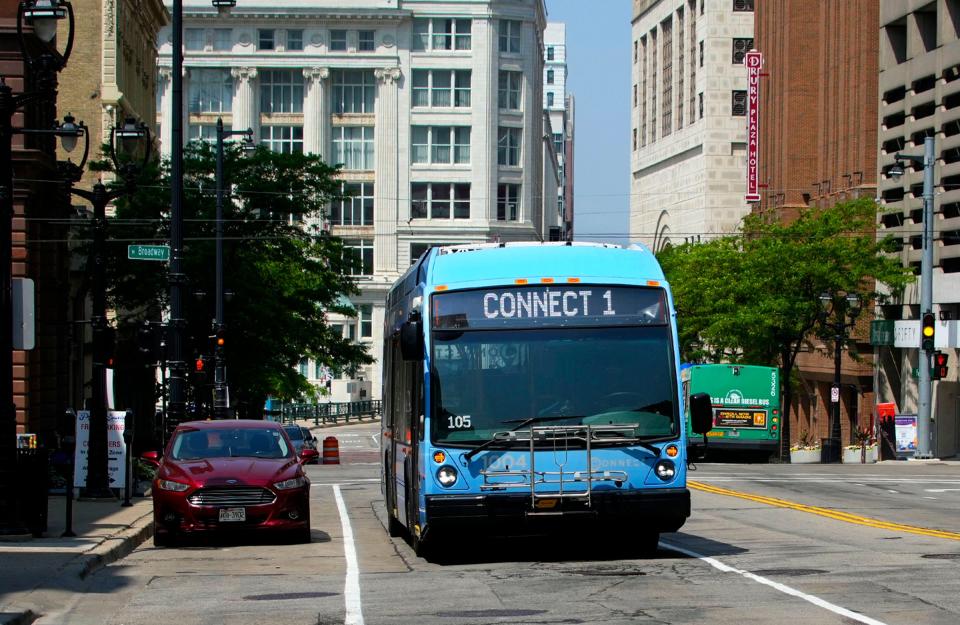Rapid transit expansion would make Milwaukee an even hotter real estate market | Opinion
In 1999, the highest-ranked public transportation system in the country was not in New York or Chicago, it was in Milwaukee. That year, the Milwaukee County Transit System (MCTS) provided a whopping 54 million trips, even rivaling larger cities with metro systems like Miami and Baltimore.
The next year, however, budget cuts started; the powers that be did not see the need for quality public transit in a stagnant, rust-belt town like Milwaukee. A vicious cycle was born: when service deteriorated, so did ridership, lowering farebox revenue and encouraging more cuts.
Ridership halved by 2019, but the pandemic really brought the system to its heels. While other cities are normalizing at around 75% of pre-Covid trips, Milwaukee's 15 million trips in 2022 put it at only half. Unlikely to reach 75% at the current rate of recovery, Milwaukee is on track for another fiscal cliff and ridership decline in 2026 when pandemic-era relief funds run out.
But just like Milwaukee’s excellent transit system was mismatched with the declining city it served in 1999, the transit system's current decayed state is mismatched with a city on the rise.
Fresh water, affordability make Milwaukee attractive
As insurance companies stop issuing new policies in natural disaster-prone states like Florida, Texas, and California; as water shortages plague everywhere from Phoenix to New Orleans; and as high prices keep people away from New York and Denver – affordable Milwaukee, situated on the calm shores one of the world’s largest freshwater lakes, is becoming an attractive destination.
Although there are still huge problems in some neighborhoods, Milwaukee’s core has rapidly become one of the hottest real estate markets in the country; there are more cranes dotting the skyline and people promenading downtown.

Despite some fiscal issues on the horizon, Milwaukee County as a whole is in a period of financial possibility. Now is the time to escape the vicious cycle before things get worse. Yet, the recently proposed 2024 budget only gives MCTS enough funding to maintain current service levels, with nearly all of the surplus going toward property tax cuts. It is undeniable that county property taxes are way too high, so spending most of the surplus on reducing them is smart. However, the yearly reduction only comes out to around $100 per household, and once that funding source is eliminated, it will not return.
So why not put $20 of those dollars toward public transit? That money, roughly $5 million in total, could be used to establish a fund for “quick build” bus rapid transit projects.
The new “Connect 1” conventional rapid transit line is fantastic – but nearly all its benefits come from dedicated lanes, all-door boarding, signal priority, and limited stops. These significantly improve speed and reliability effectively for free; and if buses can complete routes faster, they can also come by more often at no additional cost.
For example, San Francisco created “quick build” bus rapid transit lines that focused only on these cheap and easy improvements, finding they achieved 70% of conventional time-savings at 10% of the cost.
Since we know the majority of bus rapid transit’s benefits can be attained rather inexpensively, the county should also seriously reconsider the scope of its upcoming North-South BRT project. At $148 million, 20% of which is to be financed by the county, this project costs three times more than the original BRT line.

The central corridor is great, but the county should have costs at the top of mind when designing it. A good portion of the route runs through the lightly populated suburbs; south of I-43, improvements should be as economical as possible, and headways should be reduced from every 10 minutes to every 15 (although the route should terminate at Oak Creek Town Square instead of Ikea). The county should also ditch the unreliable battery-electric buses that operate poorly in Milwaukee’s frigid climate.
Bus only lanes on well-traveled routes can add appeal
The City of Milwaukee, despite having no direct responsibility for public transit, also needs to think bigger. While it embarks on a campaign to redesign streets to be friendlier for pedestrians, cyclists, and local drivers, features bus riders would appreciate are conspicuously missing. The most important of these projects is the Sherman Boulevard redesign where the 30, the busiest bus line, operates for a third of its route.
Bus-only lanes are a necessity here, and Connect 1’s stylish, but affordable new bus shelters should also be included – these principles should guide all future street reconstructions serviced by major bus routes. If the city does this for the Prospect and Farwell redesign, and if the transit system eliminates the 30’s non-Connect 1 stops on Wisconsin Avenue, Milwaukee just built a brand-new BRT line completely for free.
If done well, public transportation can offer a quintuple-digit stimulus to families, attract educated young workers, and reduce traffic better than any freeway expansion project. While a couple of rail lines would be fantastic, we do not need to break the bank to build quality public transit and achieve these benefits. All it takes to escape that vicious cycle is a little bit of vision from Milwaukee’s leaders and the people they serve – so what are we waiting for? Let’s save the bus.
A Wisconsin native, Jacob Major works as a political strategist by day and a policy activist by night.
This article originally appeared on Milwaukee Journal Sentinel: MCTS endured too many budget cuts. Milwaukee, invest in public transit

